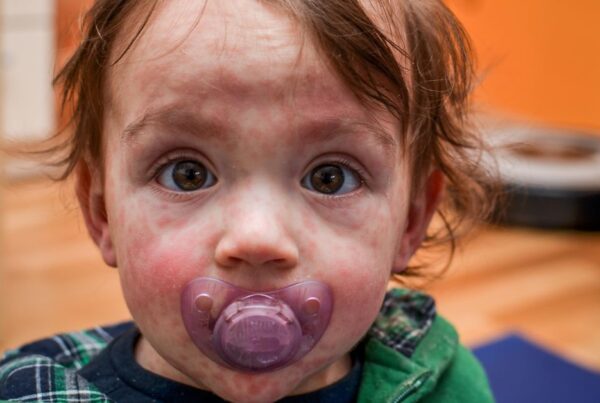Note (Feb. 2024): A previous version of this article recommended homeopathic eye drops, which are no longer available for purchase in the United States. The article has been updated accordingly.
What is Pink Eye?
Pink eye (adenovirus conjunctivitis) is a common and contagious viral infection that causes inflammation and reddening of the conjunctiva (white part of the eye). Usually adenoviral conjunctivitis starts in one eye and moves to the other after several days. Other symptoms include watery discharge, a gritty feeling in the eye, itchiness, swollen eyelids, crusted discharge, sticky eyelids, and swollen lymph nodes around the ear and jaw. Adenoviral conjunctivitis usually resolves without treatment in 4-7 days but can take as long as 2-3 weeks.
How To Treat Pink Eye
Treating adenoviral conjunctivitis involves reducing pain, antiviral treatment, and keeping everything extra clean. Let’s look at how to treat pink eye.
Pain Reduction
A good home treatment to reduce the pain associated with adenoviral conjunctivitis is a tea bag compress. Tea can be brewed as usual. When the tea bags have finished steeping, they are removed from the pot and allowed to cool until they are a comfortable temperature for a warm compress or placed in the fridge or freezer to chill for a cold compress.
The most commonly used teas are chamomile, black tea, and green tea. These three teas are anti-inflammatory and have antiviral properties. Black and green tea also have tannins and caffeine which help swollen, puffy eyes. Chamomile is soothing for painful, irritated eyes.
Artificial tears* found in the drugstore help with lubrication and comfort. Breast milk may also be used as eye drops to help soothe eyes and may help speed recovery.
*Avoid conventional eye drops with added ingredients like tetrahydrozoline or naphazoline to help with redness. They shouldn’t be used for viral conjunctivitis.
Antiviral Treatment
Adenoviral conjunctivitis will usually resolve on its own in 4-14 days. However, antiviral treatment may be able to shorten the duration of symptoms. Because viral conjunctivitis is so contagious, in my practice I often recommend the whole family take a strong immune support supplement prophylactically if someone in the house has symptoms. Look for a product that contains antibacterial and antiviral herbs, such as goldenseal, echinacea, licorice, oregon grape, wild indigo, and stevia.
Keep Everything Extra Clean
Good hygiene plays a role in reducing the spread of adenoviral conjunctivitis and helping recover sooner. Adenoviral conjunctivitis is contagious as long as symptoms are present.
- Wash hands thoroughly, especially after touching eyes and before eating.
- Wash pillowcases daily and towels after each use.
- Gently wash eyes with a wet cloth to clear away discharge.
- Don’t touch or rub eyes with fingers. Use a cloth or tissue if needed.
- Don’t use contact lenses. Consult with your optometrist to determine if they need to be cleaned or replaced in order to start wearing them again after the infection is gone (this will depend on the type of lenses).
When To Call A Doctor
Adenoviral conjunctivitis is usually not a serious condition and resolves on its own without any lingering effects. However, there are times that medical attention is required.
Seek medical attention immediately for any eye symptoms in newborns.
- If eye discharge isn’t watery, but instead consists of pus and mucus, a bacterial infection is likely. Prompt medical attention is required for green or yellow discharge. Antibiotics may be helpful.
- Seek medical attention if vision is affected and/or if bright lights cause pain.
- Seek medical attention for severe symptoms (including fever, chills, face pain) and/or for symptoms that last longer than 2 weeks.
- If you’re unsure of the cause of the pink eye, seek medical attention. Pink eye is commonly caused by an adenovirus infection, but can alternatively be caused by bacterial infections, STIs, foreign bodies in the eye, chemical irritation, and allergies. Some of these causes are serious and can cause blindness if left untreated.
Summary
Adenoviral conjunctivitis is commonly referred to as pink eye. The usual symptoms are eye redness, irritation, and watery discharge. Treatment of pink eye revolves around reducing discomfort, antivirals, and extra good hygiene. Adenoviral conjunctivitis is contagious for as long as symptoms are present.
Conjunctivitis (reddening of the white part of the eye) is often caused by adenovirus infection but can also be caused by bacterial infections, STIs, foreign bodies in the eyes, chemical irritation, and allergies. It is important to seek medical attention to determine the cause of pink eye if there is any uncertainty.
References:
Chacko, S. M., Thambi, P. T., Kuttan, R., & Nishigaki, I. (2010). Beneficial effects of green tea: a literature review. Chinese medicine, 5, 13. https://doi.org/10.1186/1749-8546-5-13
Weber, C. M., & Eichenbaum, J. W. (1997). Acute red eye. Differentiating viral conjunctivitis from other, less common causes. Postgraduate medicine, 101(5), 185–196. https://doi.org/10.3810/pgm.1997.05.246
Sugimura, T., Seo, T., Terasaki, N., Ozaki, Y., Rikitake, N., Okabe, R., & Matsushita, M. (2021). Efficacy and safety of breast milk eye drops in infants with eye discharge. Acta paediatrica (Oslo, Norway : 1992), 110(4), 1322–1329. https://doi.org/10.1111/apa.15628
Meier-Girard, D., Gerstenberg, G., Stoffel, L., Kohler, T., Klein, S. D., Eschenmoser, M., Mitter, V. R., Nelle, M., & Wolf, U. (2020). Euphrasia Eye Drops in Preterm Neonates With Ocular Discharge: A Randomized Double-Blind Placebo-Controlled Trial. Frontiers in pediatrics, 8, 449. https://doi.org/10.3389/fped.2020.00449
Bigagli, E., Cinci, L., D’Ambrosio, M., & Luceri, C. (2017). Pharmacological activities of an eye drop containing Matricaria chamomilla and Euphrasia officinalis extracts in UVB-induced oxidative stress and inflammation of human corneal cells. Journal of photochemistry and photobiology. B, Biology, 173, 618–625. https://doi.org/10.1016/j.jphotobiol.2017.06.031


